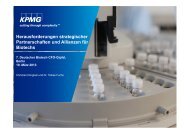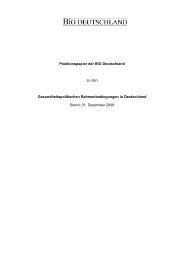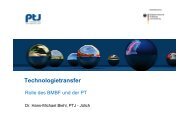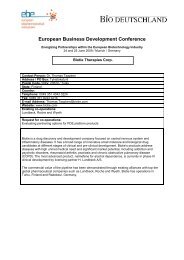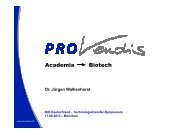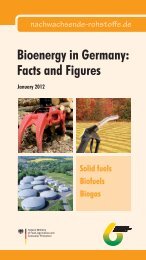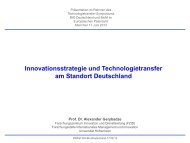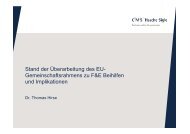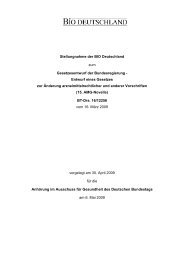Immunocore - BIO Deutschland
Immunocore - BIO Deutschland
Immunocore - BIO Deutschland
Create successful ePaper yourself
Turn your PDF publications into a flip-book with our unique Google optimized e-Paper software.
<strong>Immunocore</strong> Limited<br />
3 rd European Business Development Conference,<br />
Munich, 24-25 June 2009<br />
<strong>Immunocore</strong>
Company history<br />
Oxford University Company formed 1999<br />
Avidex<br />
Venture backed company 1999 - 2006<br />
MediGene AG<br />
Acquired Avidex September 2006<br />
<strong>Immunocore</strong><br />
Spinout October 2008<br />
<strong>Immunocore</strong>
Summary<br />
● The company focuses on making T cell receptors which are<br />
• Soluble<br />
• High affinity<br />
• Able to target intracellular antigens<br />
● Dominant ip and know-how from 10 years of research<br />
● Development candidate in progress<br />
<strong>Immunocore</strong>
<strong>Immunocore</strong>’s monoclonal T cell receptors<br />
● T cell receptors are the body’s own targeting mechanism<br />
to identify diseased cells through antigens<br />
● <strong>Immunocore</strong> can make mTCRs for any antigen, which<br />
leads directly to a novel pipeline platform in<br />
• Cancer<br />
• Viral disease<br />
<strong>Immunocore</strong>
Breaking immune tolerance to cancer<br />
● The immune system has far more cytotoxic potential and<br />
versatility than any single-target drug<br />
● However, the immune system is tolerant to cancers<br />
● Breaking tolerance would be most potently achieved with<br />
T cells and requires 2 components:<br />
• Better detection of cell-surface antigens<br />
• More potent T cell activation<br />
<strong>Immunocore</strong>
Affinity-enhanced TCR therapeutics<br />
targeting intracellular antigens<br />
<strong>Immunocore</strong>
Cell antigen targeting by mAbs and mTCRs<br />
Disease associated proteins<br />
(DAPs)<br />
DAPs processed into peptide antigens<br />
Intracellular proteins<br />
constitute ~75% of all<br />
disease-relevant<br />
antigens<br />
mAbs – can target<br />
membrane anchored<br />
antigens<br />
<br />
<br />
<br />
mTCRs – can target<br />
all cellular antigens –<br />
including those from<br />
intracellular proteins<br />
<strong>Immunocore</strong>
Molecular evolution to increase mTCR affinities for target<br />
Specificity Affinity-K D Binding half-life<br />
NY-ESO 1 32 μM 7 s<br />
----------> 26 pM 19 h<br />
MAGE-A3 281 μM nd<br />
----------> 58 pM 9 h<br />
Telomerase 38 μM 3 s<br />
----------> 65 pM 39 h<br />
gp100 85 μM nd<br />
----------> 11 pM 33 h<br />
WT1 96 μM nd<br />
----------> 16 pM 12 h<br />
Wild-type TCR values in grey, affinity matured versions in blue<br />
nd (not determined) due to kinetics of binding being too fast for measurement<br />
<strong>Immunocore</strong>
High affinity mTCRs target where natural affinity TCRs fail<br />
In vivo<br />
High affinity mTCR<br />
Natural affinity mTCR<br />
Mice with 100mm 3 melanomas<br />
<strong>Immunocore</strong>
Problem with immune system: natural T cells require 100-500<br />
antigens on cell surface to activate<br />
No. of antigens<br />
per cell<br />
1 10 20 50 100 500<br />
Normal T cell<br />
reactivity<br />
- max activation<br />
- no activation<br />
Detection window<br />
Positive selection during maturation restricts<br />
T-cells to a narrow epitope detection window<br />
<strong>Immunocore</strong>
Cancer cells avoid T cell activation by antigen down-regulation<br />
Tumour cell presentation<br />
No. of antigens<br />
per cell<br />
1 10 20 50 100 500<br />
Normal T cell<br />
reactivity<br />
Minority of T-cells mount<br />
anti-tumour response<br />
Tumour escape<br />
- max activation<br />
- no activation<br />
This tumour escape window may be the reason why cancer vaccines have limited efficacy<br />
<strong>Immunocore</strong>
High affinity mTCRs overcome tumour escape<br />
Tumour cell presentation<br />
No. of antigens<br />
per cell<br />
1 10 20 50 100 500<br />
Normal T cell<br />
reactivity<br />
Minority of T-cells mount<br />
anti-tumour response<br />
- max activation<br />
- no activation<br />
mTCR redirected<br />
T cell activity<br />
Majority of T-cells mount<br />
anti-tumour response<br />
- max activation<br />
- no activation<br />
<strong>Immunocore</strong>
Creating a product<br />
<strong>Immunocore</strong>
Cancer Specific mTCRs: Mechanism of Action<br />
●<br />
●<br />
●<br />
High affinity mTCRs bind<br />
unique cancer antigen<br />
Anti-CD3 binds CD3 on<br />
any T cell including<br />
• T cells specific for the<br />
cancer and<br />
• T cells specific for other<br />
antigens, e.g. for EBV<br />
or flu<br />
Redirected T cells then<br />
kill the tumour cell<br />
Non-tumour<br />
specific TCR<br />
CTL<br />
killing<br />
CD3<br />
Tumour cell<br />
Polyclonal T-cells<br />
Tumour antigen-specific<br />
high affinity mTCR<br />
Anti-CD3 scFv<br />
Activation of T cell and<br />
re-direction of killing<br />
through CD3<br />
<strong>Immunocore</strong>
Key features of in vitro data<br />
● Natural cell lines used – not transfected with antigen<br />
● 75-100 antigens per cell<br />
● Realistic effector-to-target ratios in killing assays<br />
● Key in vitro question: can high affinity mTCRs trigger cell<br />
killing with these natural cell lines?<br />
<strong>Immunocore</strong>
High affinity TCR activated to naturally presenting tumour<br />
cells ignored by low affinity TCRs<br />
CD8 T cells re-directed by mTCR-antiCD3 fusions<br />
against naturally presenting tumour cells<br />
IFN-γ release (no. of spots)<br />
300<br />
200<br />
100<br />
0<br />
Tumour cells<br />
+ T cells<br />
Controls -14 -13 -12 -11 -10 -9 -8 -7<br />
TCR concentration: low->high<br />
High affinity TCR<br />
Medium-high affinity TCR<br />
Medium affinity TCR<br />
Medium-low affinity TCR<br />
WT (natural) affinity TCR<br />
Tumour cells + T cells<br />
T cells<br />
T cells + PHA (activating reagent)<br />
<strong>Immunocore</strong>
EBV-specific T cells redirected by TCR-anti-CD3 kill<br />
melanoma cells<br />
Mel 624 cell line (melanoma) with EBV T cell clone (effector:target = 5:1) and TCR-antiCD3<br />
70<br />
Cytotoxicity (%)<br />
60<br />
50<br />
40<br />
30<br />
20<br />
10<br />
0<br />
-10<br />
-14 -13 -12 -11 -10 -9 -8 -7<br />
TCR-antiCD3 concentration in M<br />
Tumour cells<br />
+ T cells<br />
gp100<br />
Melan A<br />
Melan A + gp100<br />
Control (no TCR )<br />
Mel 624 cells:<br />
gp100 ~ 50 antigens per cell<br />
Melan A ~ 125 antigens per cell<br />
<strong>Immunocore</strong>
Video microscopy: visualising mTCR target specificity<br />
(2 hour timeframe)<br />
●<br />
●<br />
●<br />
●<br />
Red cells = cancer cells<br />
Green cells = innocent bystanders<br />
Clear cells = non-cancer specific T cells<br />
mTCR-anti-CD3 added at 0.1nM<br />
<strong>Immunocore</strong>
Mechanism of Action: anti-CD3 avidity requirement for activation<br />
Target cell with non-matching antigen<br />
Non-target (normal) cell<br />
Target cell with matching antigen<br />
Target (tumour) cell<br />
mTCR<br />
Nonmatching<br />
antigen<br />
CTL<br />
killing<br />
Matching<br />
antigen<br />
Anti-CD3<br />
mTCR<br />
Anti-CD3<br />
Non-tumour<br />
specific TCR<br />
CD3<br />
Non-tumour<br />
specific TCR<br />
CD3<br />
Polyclonal T-cells<br />
Polyclonal T-cells<br />
IFNg release (pg/ml)<br />
7500<br />
5000<br />
2500<br />
Targets with 10 -9 melan A antigen<br />
(non-matching)<br />
IFNg release (pg/ml)<br />
7500<br />
5000<br />
2500<br />
Targets with 10 -9 NY-ESO<br />
antigen (matching)<br />
0<br />
0<br />
-13 -12 -11 -10 -9<br />
Log [NYEmTCR-anti CD3-3] (M)<br />
-13 -12 -11 -10 -9<br />
Log [NYEmTCR-anti CD3-3] (M)<br />
<strong>Immunocore</strong>
In vivo data<br />
<strong>Immunocore</strong>
Melan A efficacy study<br />
(naturally presenting tumour cells)<br />
400<br />
5x10 5 Mel526 (tumour) cells plus 10 6 PBMCs (T cells) injected s.c. day 0<br />
TCR dosed i.v. days 0-4 at 0.04mg/Kg<br />
Average<br />
Tumour Volume mm 3<br />
300<br />
200<br />
100<br />
Tumour cells + T cells<br />
Tumour cells only<br />
Tumour cells + T cells + TCR<br />
0<br />
0 10 20 30 40<br />
Dosing<br />
Day<br />
Estimated effector:target ratio<br />
(T cells:tumour cells):<br />
1:1<br />
<strong>Immunocore</strong>
Donor engraftment variation observed in melanoma model<br />
(NB. Tumour cells eradicated)<br />
(NB. PBMCs from donor B<br />
did not engraft in the mice)<br />
(NB. Tumour cells eradicated)<br />
Mel526 cells<br />
Mel526 cells + PBMCs<br />
Mel526 cells + PBMCs<br />
+ Drug (0.04mg/Kg)<br />
Dosing period<br />
(days 0-4)<br />
(NB. Tumour being actively<br />
controlled 36 days after last<br />
dose of drug)<br />
<strong>Immunocore</strong>
CAM003 – Melan-A TCR stimulates PBMC proliferation in vivo<br />
Tumour sections (x4 magnification)<br />
stained for human CD3 + T cells<br />
(dark brown colour)<br />
Control Group<br />
5x10 5 Tumour cells<br />
1x10 6 PBMCs<br />
PBS vehicle<br />
Control Group<br />
5x10 5 Tumour cells<br />
No PBMCs<br />
PBS vehicle<br />
Treated Group<br />
5x10 5 Tumour cells<br />
1x10 6 PBMCs<br />
Melan A mTCR-anti-CD3<br />
reagent (0.04mg/Kg)<br />
<strong>Immunocore</strong>
Key points from in vivo studies<br />
● Extremely low doses (0.04mg/kg) can obliterate tumours<br />
● Histology on mice demonstrates mTCR drives excellent<br />
tumour T cell infiltration<br />
● No histology possible on 4 out of 8 mice because no<br />
tumour present<br />
<strong>Immunocore</strong>
Monoclonal TCR Pipeline<br />
Antigen target HLA type Cancer Indications<br />
Gp100<br />
HLA-A2 Melanoma<br />
NY-ESO 1<br />
HLA-A2 Multiple myeloma<br />
Telomerase<br />
HLA-A2 Head and neck, pulmonary, renal<br />
WT-1<br />
HLA-A2 Leukaemia, ovarian, colorectal, renal<br />
MAGE A3<br />
HLA-A1 NSCLC, RCC, HCC<br />
PSCA<br />
HLA-A2 Prostate, bladder, pancreatic<br />
Survivin<br />
HLA-A2 SCLC, breast, HCC<br />
Her-2neu<br />
HLA-A2 Breast<br />
WT-1<br />
HLA-A24 Leukaemia, ovarian, colorectal, renal<br />
MAGE A3 HLA-A2 NSCLC, RCC, HCC<br />
Antigen target HLA type Infectious Disease Indication<br />
HIV gag<br />
HCV<br />
HLA-A2<br />
HLA-A2<br />
HIV AIDS<br />
Hepatitis C<br />
<strong>Immunocore</strong>
Overall summary<br />
●<br />
●<br />
●<br />
<strong>Immunocore</strong> has a pipeline of mTCRs targeting multiple cancers<br />
High affinity mTCRs can overcome antigen down-regulation in<br />
vitro and in vivo<br />
The anti-CD3 effector function can<br />
• Redirect T cell killing at extremely low concentrations<br />
• Prevent tumour formation over extended periods in vivo<br />
● Gp100 development candidate being progressed to clinic in 2010<br />
●<br />
<strong>Immunocore</strong> seeking partners across the pipeline<br />
<strong>Immunocore</strong>
<strong>Immunocore</strong> Limited<br />
3 rd European Business Development Conference,<br />
Munich, 24-25 June 2009<br />
<strong>Immunocore</strong>




